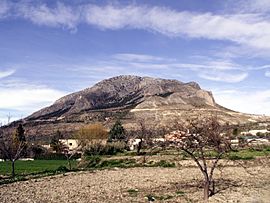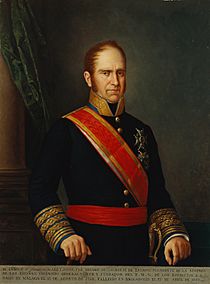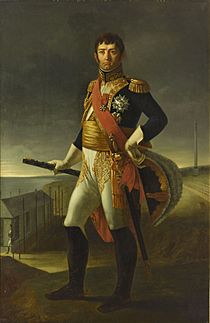Battle of Zújar facts for kids
Quick facts for kids Battle of Zújar |
|||||||
|---|---|---|---|---|---|---|---|
| Part of Peninsular War | |||||||
 The Cerro Jabalcon towers over Zújar. |
|||||||
|
|||||||
| Belligerents | |||||||
| Commanders and leaders | |||||||
| Strength | |||||||
| Campaign: 12,000 Zújar: 4,600–8,000 |
Campaign: 17,000 Zújar: 4,000 |
||||||
| Casualties and losses | |||||||
| Campaign: unknown Zújar: light |
Campaign: 4,000 Zújar: 1,423 |
||||||
The Battle of Zújar was a fight during the Peninsular War on August 9, 1811. This war was part of the bigger Napoleonic Wars, where France fought against many European countries. In this battle, a French army division, led by Nicolas Godinot, attacked a Spanish division. The Spanish soldiers were part of the Army of Murcia, led by Manuel Alberto Freire de Andrade y Armijo.
The French won the battle, causing heavy losses for the Spanish division, which was commanded by Joseph O'Donnell. Zújar is a town in Spain, located about 13 kilometers (8 miles) northwest of Baza.
During the summer of 1811, Spanish armies were trying to weaken France's control over southern Spain. Marshal Nicolas Soult, a French commander, moved his troops to deal with the Spanish Army of Murcia. The Spanish army, led by Freire, had some early success. However, when Soult arrived with more French soldiers, the situation changed. Godinot's French division defeated O'Donnell's Spanish division at Zújar. This battle allowed Freire's main army to escape, but his rear guard (the soldiers protecting the back of the army) was later defeated by French cavalry. After these defeats, the Spanish Army of Murcia broke apart and scattered into the mountains.
Contents
Why the Battle Happened
Spanish Army's Move
Since a big battle in Baza in November 1810, the Spanish Army of Murcia had not done much. The French IV Corps was defending against them. But in April 1811, Marshal Nicolas Soult started moving French troops away from this area. He needed them to fight an Anglo-Portuguese (British and Portuguese) army further west. Because of this, the French IV Corps became much weaker.
General Manuel Alberto Freire de Andrade y Armijo was in charge of the Spanish Army of Murcia. In June 1811, he had about 14,453 soldiers. Seeing that the French were weaker, Freire decided to move his army westward. He advanced slowly, which allowed the French general, Jean François Leval, to retreat without being rushed. Even so, the French had to give up control of the coast and towns like Baza and Guadix. Spanish troops also caused trouble for French supply lines.
French Counter-Attack
Meanwhile, a big battle happened at Battle of Albuera in May 1811, where the French suffered a major defeat. After this, Marshal Soult heard that the Spanish armies were active. He decided to leave another French army to watch the British and Portuguese, and he marched south with his own troops.
Soult first went to Niebla, where another Spanish general, Joaquín Blake y Joyes, was attacking a French base. Blake's troops quickly moved by sea to Cádiz. From there, Blake sailed to Almería with about 7,000 infantry and 500 cavalry. He joined Freire's army near Baza on August 3, 1811. This meant the Spanish army now had about 15,000 foot soldiers and nearly 2,000 horsemen.
With so many Spanish troops, General Leval's French force was in a very dangerous spot. However, Blake soon left to prepare the city of Valencia for another French army. This left Joseph O'Donnell in temporary command of Blake's division.
Soult's Arrival
Freire had a great chance to defeat the French, but he moved very slowly. Marshal Soult heard about the Spanish forces growing stronger. He quickly marched from Seville and arrived at Granada on August 7. On August 9, Soult reached the Gor ravine, where Freire's army was positioned. Soult had about 6,000 infantry and 1,500 cavalry. The Spanish position was very strong, so Soult did not attack directly.
Instead, Soult had ordered General Nicolas Godinot to advance from Jaén. Godinot left Baeza on August 7 with at least 4,000 foot soldiers and 600 horsemen. This French advance forced a Spanish division to retreat. Freire then sent O'Donnell's 4,000 men to block Godinot's path at Zújar.
The Battle of Zújar
On August 9, 1811, Godinot's French division met O'Donnell's Spanish troops at Zújar. Godinot's force was quite large, possibly up to 8,000 men. O'Donnell placed his soldiers behind the Guardal River, near the edge of the town, hoping for more Spanish troops to arrive.
In the afternoon, Godinot's French soldiers attacked the Spanish. The French quickly defeated O'Donnell's division. The Spanish lost many soldiers: 423 were killed or wounded, and 1,000 were captured or went missing. This was a clear victory for the French.
Aftermath of the Battle
After the battle, Godinot's French troops were only about 8 kilometers (5 miles) from Baza. If they took Baza, they could cut off Freire's escape route. However, Godinot's soldiers were tired from marching and fighting, so he paused.
Meanwhile, Freire heard about O'Donnell's defeat. That evening, he quickly moved his entire army away from the Gor ravine and marched through Baza during the night. The next morning, August 10, Soult found the Spanish lines empty. He immediately sent his cavalry to chase after Freire's army.
The French cavalry caught up with Freire's rear guard (the troops at the back of the army) about 10 kilometers (6 miles) east of Baza. The Spanish general had placed two divisions to protect his main infantry. But General of Brigade Pierre Benoit Soult led a strong charge that defeated the Spanish cavalry. With their cavalry broken, the Spanish infantry left the main road and headed for the hills. The Spanish army split into two groups, retreating in different directions. Some marched north, and others went south. They moved so fast that one group covered 37 miles (60 km) in a single day.
Marshal Soult reached Vélez-Rubio with 12,000 troops. With Freire's army split, the city of Murcia was left unprotected. However, Soult decided to focus on fighting local groups of fighters called guerillas instead of attacking Murcia. On August 14, the two parts of the Spanish army met up again near Murcia, where General Blake rejoined them. The Spanish army had lost about 4,000 men during this campaign.
Soult then turned his army back west and divided it into several groups to hunt down the guerilla bands. The French were very harsh in the countryside, attacking villages and shooting people.
The French did not have everything go their way. Some guerilla fighters captured French soldiers near Motril. Soon after, they also fought off a larger French force. The next battle in this area was the Battle of Bornos in November 1811.
Images for kids




